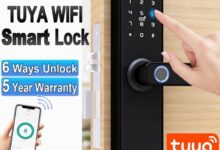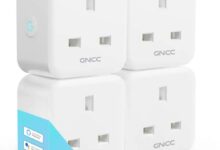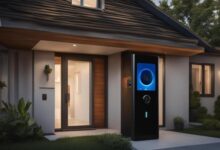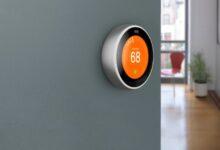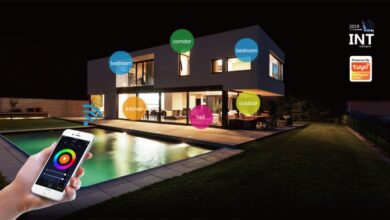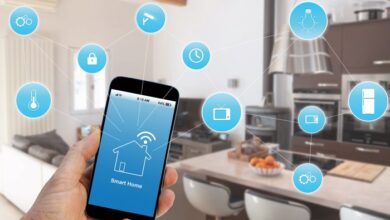Automated Blinds Smart Home Upgrade
Automated Blinds: Step into a world of effortless luxury and unparalleled convenience. Imagine waking up to gentle sunlight filtering through your windows, or enjoying a movie night bathed in the perfect ambient glow – all without lifting a finger. This isn’t science fiction; it’s the reality of automated blinds, transforming homes into havens of comfort and efficiency.
From motorized marvels to sleek smart-home integrations, the possibilities are as limitless as your imagination. We’ll delve into the diverse types, remarkable benefits, and seamless integration of these innovative window treatments, guiding you towards the perfect automated solution for your unique needs.
This comprehensive guide covers everything from choosing the right material and control system to installation, maintenance, and smart home integration. We’ll explore the cost considerations, showcase real-world examples in different settings, and answer your burning questions, empowering you to make an informed decision that elevates your home and lifestyle.
Types of Automated Blinds
The rise of smart homes has propelled automated blinds into the mainstream, transforming window treatments from simple décor elements into sophisticated tools for light control, energy efficiency, and enhanced security. Understanding the various types available is crucial for making an informed choice that best suits your needs and lifestyle. This exploration delves into the mechanisms, materials, and control methods that define the modern automated blind landscape.
Automated Blind Mechanisms
Automated blinds utilize various mechanisms to achieve their motorized functionality. Motorized blinds are the most common type, using a small electric motor to raise and lower the blinds. These motors can be corded, where a cord is attached to the motor for winding, or cordless, relying on internal gearing. Battery-powered blinds offer the advantage of wireless operation, eliminating the need for hardwiring and making installation simpler, particularly in older homes.
Finally, smart home integration connects blinds to a central system, allowing control via apps, voice assistants, or even automated schedules based on sunrise and sunset times. For instance, a Lutron Serena system allows for precise scheduling and remote operation, while Somfy offers a wide range of integration options with various smart home platforms.
Automated Blind Materials
The material of your automated blinds significantly impacts their durability, light control, and overall aesthetic. A variety of materials are used, each with its own advantages and disadvantages. The following table provides a comparison of common materials:
| Material | Durability | Light Control | Cost |
|---|---|---|---|
| Wood | High; resistant to damage but susceptible to moisture | Moderate to high, depending on slat width and finish | High |
| Fabric | Moderate; prone to fading and staining; varies widely by fabric type | Low to high; sheer fabrics allow diffused light, while blackout fabrics block most light | Moderate to High |
| Aluminum | High; resistant to damage and moisture | High; slats effectively block light | Moderate |
| Bamboo | Moderate; susceptible to moisture and insect damage | Moderate; allows diffused light | Moderate |
Automated Blind Control Methods
Controlling your automated blinds is as diverse as the blinds themselves. Remote control offers a convenient way to adjust your blinds from anywhere in the room. App control, often integrated with smart home systems, provides precise scheduling and remote access from anywhere with an internet connection. Voice control, through compatibility with smart speakers like Amazon Alexa or Google Home, allows for hands-free operation, adding a layer of convenience and seamless integration into daily routines.
Many systems allow for a combination of these control methods, providing maximum flexibility and ease of use. For example, you might schedule your blinds to open automatically each morning via an app, then adjust them manually throughout the day using a remote control, and finally close them at sunset with a voice command.
Benefits of Automated Blinds
Smart homes are increasingly popular, and automated blinds are a key component driving this trend. Beyond the initial wow-factor, the advantages of automated blinds extend to energy efficiency, enhanced security, and a significantly improved lifestyle. Let’s delve into the specifics of how these innovative window treatments benefit homeowners.
Energy Efficiency with Automated Blinds
Automated blinds offer significant energy savings throughout the year. By automatically adjusting to the sun’s position, they minimize heat gain during the summer and reduce heat loss during the winter. In summer, closed blinds reflect sunlight, keeping interiors cooler and reducing the strain on air conditioning systems. Conversely, during winter, strategically opened blinds allow sunlight to passively heat rooms, lowering heating demands.
Studies have shown that automated blinds can reduce energy consumption by up to 15%, leading to significant cost savings on utility bills over time. Consider a household in Arizona, where summer temperatures soar. Automated blinds could significantly reduce their reliance on air conditioning, leading to a substantial reduction in their monthly electricity bill. This translates to both financial savings and a smaller carbon footprint.
Enhanced Security Features
Automated blinds provide a surprisingly effective security boost. Their programmable timers can simulate occupancy, even when the house is empty. This creates the illusion that someone is home, deterring potential burglars. Imagine setting your blinds to open and close at various times throughout the day, mimicking a normal household routine. This seemingly simple action can be a significant deterrent, adding an extra layer of protection to your home.
Furthermore, the ability to remotely control your blinds allows you to adjust them based on real-time security concerns, such as adjusting blinds upon receiving a security alert.
Do not overlook the opportunity to discover more about the subject of Smart Home Devices.
Convenience and Lifestyle Improvements
The convenience factor is undeniable. Imagine waking up to gently rising blinds, welcoming the sunlight into your bedroom. Or, picture yourself effortlessly adjusting your blinds from your phone, regardless of your location, to control the amount of light and privacy in your home. This level of control and automation streamlines daily routines and adds a touch of luxury to everyday life.
The benefits extend beyond mere convenience; automated blinds can improve overall well-being by optimizing light levels throughout the day, contributing to better sleep and mood regulation. For individuals with mobility challenges, the ease of use offered by automated blinds is particularly significant, enhancing independence and quality of life.
Marketing Blurb: Experience the Smart Home Advantage
Tired of manually adjusting your blinds? Upgrade to automated blinds and enjoy effortless control, increased energy savings, and enhanced home security. Programmable timers simulate occupancy, deterring intruders, while automated adjustments optimize natural light and temperature, saving you money on energy bills. Experience the ultimate in convenience and elevate your lifestyle with the smart home solution you’ve been waiting for.
Installation and Maintenance of Automated Blinds
Upgrading your home with automated blinds offers unparalleled convenience and style. However, realizing the full potential of these smart window treatments requires understanding both their installation and ongoing maintenance. This section will equip you with the knowledge to seamlessly integrate automated blinds into your home and ensure their long-term performance. From a straightforward installation process to troubleshooting common issues and implementing a simple maintenance routine, we’ll cover everything you need to know.
Installing Different Types of Automated Blinds
Proper installation is crucial for optimal functionality and longevity. Different automated blind types require slightly different approaches. The following steps provide a general guide; always refer to your specific product’s instructions for detailed guidance.
- Preparation: Measure your window carefully and ensure you have all the necessary tools and hardware, including a drill, level, and appropriate mounting brackets. Carefully read the manufacturer’s instructions before starting.
- Mounting Brackets: Attach the mounting brackets securely to the window frame or ceiling, using a level to ensure they are perfectly aligned. The positioning will depend on the type of blind (inside mount or outside mount).
- Blind Installation: Carefully attach the blind mechanism to the mounted brackets, ensuring a snug and secure fit. This step often involves sliding the blind into the brackets or attaching it with screws.
- Wiring (for motorized blinds): Connect the power supply to the blind’s motor according to the manufacturer’s instructions. This might involve connecting to a wall outlet, a smart home hub, or a battery pack.
- Testing and Calibration: After installation, test the automated functions (up/down, tilt) to ensure they work correctly. Many systems require initial calibration to set the limits of travel.
- Programming (Smart Blinds): If your blinds are smart, connect them to your Wi-Fi network and program them using the corresponding app. This allows for remote control and scheduling.
Troubleshooting Common Issues with Automated Blinds
Even with careful installation, minor issues can arise. Addressing these promptly prevents escalation.
- Blinds not responding: Check the power supply (batteries, outlet, smart home connection). Ensure the blind’s motor is not jammed or obstructed.
- Inconsistent movement: This could indicate a problem with the motor, gears, or the power source. Examine the mechanism for any signs of damage or obstruction.
- Remote control issues: Check the batteries in the remote and ensure it is within range of the blind’s receiver. Try re-pairing the remote to the blind if necessary.
- Uneven operation: This often results from incorrect installation or calibration. Recheck the installation and recalibrate the blind according to the manufacturer’s instructions.
- Noisy operation: Excessive noise could be due to loose parts or worn components. Inspect the mechanism for loose screws or worn gears and lubricate moving parts if necessary (following manufacturer guidelines).
Routine Maintenance Procedures for Automated Blinds
Regular maintenance is key to preserving the performance and extending the lifespan of your automated blinds.
| Maintenance Task | Frequency | Required Tools | Notes |
|---|---|---|---|
| Dusting and Cleaning | Monthly | Soft cloth, mild detergent (if needed) | Gently wipe down the blind slats and mechanism to remove dust and debris. Avoid harsh chemicals. |
| Lubrication of Moving Parts | Annually | Silicone-based lubricant (manufacturer-approved) | Apply a small amount of lubricant to moving parts as per manufacturer instructions. Excessive lubrication can attract dust. |
| Inspection for Damage | Annually | None | Check for any signs of damage to the slats, motor, or other components. Address any issues promptly. |
| Battery Replacement (if applicable) | As needed (depending on battery life) | Replacement batteries | Replace batteries according to the manufacturer’s instructions. Use high-quality batteries for optimal performance. |
Smart Home Integration and Automation
Stepping into the world of smart homes seamlessly integrates automated blinds, transforming them from simple window coverings into sophisticated components of a connected ecosystem. This integration unlocks a new level of convenience, energy efficiency, and home security, all managed from a central hub or your smartphone. The possibilities are as limitless as your imagination, and the benefits are undeniable.Automated blinds aren’t just about convenience; they are key players in creating a truly intelligent home.
Through strategic integration with other smart devices and systems, you can automate lighting, temperature control, and even security features to create personalized scenes and schedules that adapt to your lifestyle and preferences. This interconnectedness allows for a level of home management previously only dreamed of.
Smart Home Platform Compatibility
Choosing the right smart home platform is crucial for seamless integration. Popular platforms like Amazon Alexa, Google Home, Apple HomeKit, and Samsung SmartThings each offer unique features and levels of compatibility with automated blinds. Some blinds come pre-integrated with specific platforms, while others require additional smart home hubs or bridges for connectivity. For instance, a blind designed for Alexa integration might utilize the Alexa app for voice control, schedule creation, and integration with other Alexa-compatible devices.
In contrast, a blind compatible with HomeKit would require an Apple device and would benefit from its tight integration with other Apple products. The level of integration can significantly affect the ease of use and functionality.
Setting Up Automated Schedules and Scenes
Creating automated schedules and scenes with your automated blinds is surprisingly intuitive. Most systems involve downloading a dedicated app, connecting your blinds to your Wi-Fi network, and then programming specific times or events to trigger actions. For example, you could schedule your blinds to open automatically at sunrise and close at sunset, optimizing natural light and energy consumption. Furthermore, you can create scenes that combine blind control with other smart home functions.
A “Good Morning” scene might open the blinds, turn on the lights, and adjust the thermostat, all with a single tap on your smartphone or a voice command. These scenes are highly customizable and adaptable to your individual preferences and routines.
Integration with Other Smart Home Devices
The true power of automated blinds is realized through their interaction with other smart home devices. Imagine this: your smart security system detects motion outside your home, triggering your blinds to close automatically, providing an added layer of security. Or perhaps your smart thermostat detects a significant temperature increase, prompting your blinds to close and prevent the room from overheating.
Similarly, integration with smart lighting systems can create dynamic lighting scenes that complement the position of your blinds. This interconnectedness creates a truly intelligent and responsive home environment, maximizing comfort and efficiency. The possibilities for customization are virtually endless, depending on the specific devices and platforms you utilize.
Cost and Considerations
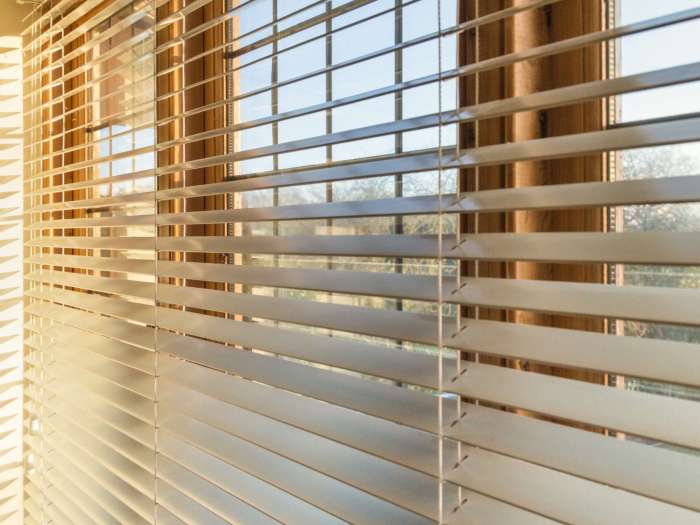
Investing in automated blinds is a significant decision, impacting both your home’s aesthetics and your budget. Understanding the various cost factors and making informed choices is crucial for a successful installation. This section will delve into the key elements influencing the overall price and help you navigate the decision-making process.
Several factors contribute to the final cost of automated blinds. The most significant are the size and type of window, the chosen material, and the level of technological sophistication incorporated into the system. Larger windows naturally require more material and potentially more complex motorization, driving up the cost. Similarly, premium materials like natural wood or high-performance fabrics will command a higher price tag than more basic options.
Finally, features like integrated smart home compatibility, advanced scheduling options, and sophisticated control interfaces add to the expense.
Automated Blind Pricing
The price range for automated blinds varies considerably depending on the factors discussed above. The following table provides a general overview of typical cost ranges. Remember, these are estimates, and actual prices can fluctuate based on retailer, installation costs, and specific product features.
| Blind Type | Material | Features | Price Range (USD) |
|---|---|---|---|
| Roller Shades | Polyester | Basic Motorization | $100 – $300 per blind |
| Cellular Shades | Fabric | Smart Home Integration | $200 – $500 per blind |
| Venetian Blinds | Wood | Advanced Scheduling | $300 – $700 per blind |
| Roman Shades | High-End Fabric | Customizable Controls | $400 – $1000+ per blind |
Choosing the Right Blinds for Different Rooms
Selecting the appropriate automated blinds hinges on several factors, including the room’s function, the size of the windows, and the desired level of light control. For example, a bedroom might benefit from light-blocking cellular shades for optimal sleep, while a living room could utilize elegant Venetian blinds for precise light adjustment. Larger windows in a great room may necessitate a more robust motorized system capable of handling heavier blinds.
Consider the following when making your selection: A sunroom, often bathed in sunlight, might benefit from highly effective light-filtering blinds. A bathroom might prioritize moisture-resistant materials, such as waterproof roller shades. A home office could incorporate smart blinds with precise light control to enhance productivity. Careful consideration of these factors ensures that the chosen automated blinds meet both aesthetic and functional requirements.
For instance, a large picture window in a living room might benefit from the elegant look and functionality of motorized Venetian blinds, while smaller windows in a kitchen could utilize more cost-effective roller shades.
Illustrative Examples of Automated Blinds in Different Settings
Automated blinds offer a compelling blend of convenience, energy efficiency, and aesthetic enhancement across diverse environments. Their ability to seamlessly integrate with smart home systems further amplifies their value, transforming how we interact with our living and working spaces. Let’s explore how these systems function in various settings.
Automated Blinds in a Modern Office Setting
Imagine a sleek, modern office space. Sunlight streams through expansive windows, potentially creating glare on computer screens and causing discomfort for employees. Here, automated roller blinds made from a light-filtering fabric, such as cellular shades or sheer fabrics, offer a practical solution. These blinds are controlled via a centralized system, perhaps a Lutron system or a similar smart home platform, allowing managers to schedule adjustments based on the time of day or even sunlight intensity detected by sensors.
For privacy, the blinds can be fully lowered during confidential meetings or after hours. The benefits are clear: improved employee comfort and productivity through optimized lighting, enhanced security through automated privacy control, and energy savings through reduced reliance on artificial lighting and HVAC systems. For instance, a company using automated blinds might see a 15-20% reduction in energy costs annually compared to manually operated blinds, based on studies comparing energy usage in similar office buildings.
Automated Blinds in a Bedroom Setting
The bedroom, a sanctuary of rest and rejuvenation, benefits significantly from automated blinds. Consider cellular shades or blackout blinds, known for their excellent light-blocking capabilities. These can be programmed to open gradually at sunrise, mimicking a natural wake-up call, and close automatically at sunset to promote better sleep hygiene. A simple smart home app or a dedicated smart blind control system allows for customized scheduling and on-demand adjustments.
The resulting benefits are noticeable: improved sleep quality through controlled light exposure, a more restful and peaceful sleep environment, and enhanced privacy. This translates to improved mood, increased energy levels, and better overall well-being. For example, a study published in the Journal of Sleep Research indicated a correlation between light exposure at night and sleep disturbances; automated blinds directly mitigate this issue.
Automated Blinds in a Living Room Setting
In the living room, automated blinds seamlessly blend functionality with aesthetics. Consider Venetian blinds or sleek, modern roller blinds in a variety of fabrics and colors to complement your existing décor. A smart home hub or a dedicated remote control allows for effortless adjustment, creating different ambiances throughout the day. For instance, during the day, the blinds can be partially open to allow soft, diffused light to filter in, creating a warm and inviting atmosphere.
In the evening, they can be closed for privacy and to enhance the mood lighting from lamps and other fixtures. The benefits include improved light control, increased privacy, and enhanced aesthetic appeal, transforming the living room into a space that adapts effortlessly to different moods and occasions. The flexibility offered by automated systems allows homeowners to easily tailor the lighting and atmosphere to match their daily routines and preferences.
Last Recap
Ultimately, the choice to embrace automated blinds is an investment in both comfort and efficiency. From the energy savings and enhanced security to the unparalleled convenience and aesthetic appeal, the benefits far outweigh the initial cost. By understanding the various types, features, and integration options, you can transform your home into a smart, stylish, and effortlessly controlled environment.
So, take the plunge and discover how automated blinds can revolutionize your living experience, one perfectly-lit room at a time. This journey into the world of automated window treatments is just the beginning – explore, innovate, and elevate your home to new heights of comfort and control.
